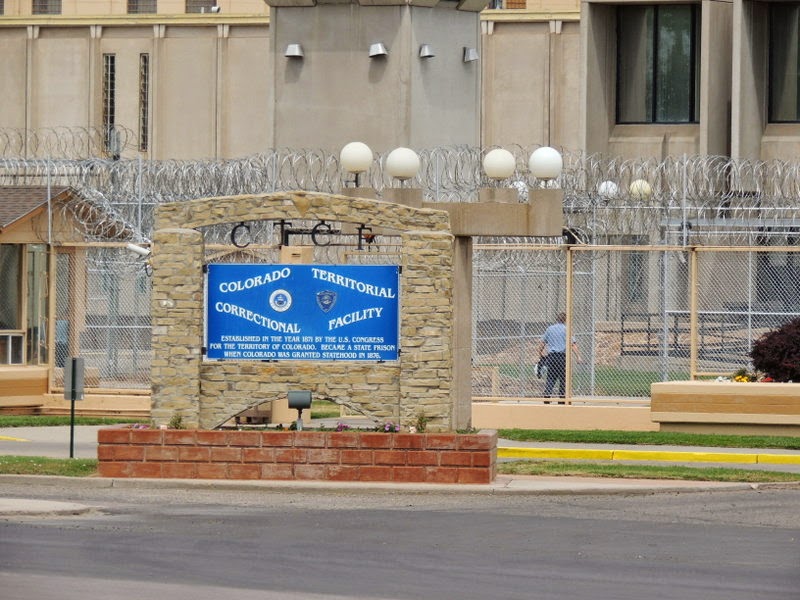10. Raton, NM to West Pueblo, CO (Part 1)
We left Raton going north on I-35 over the Raton Pass, elevation
7835 feet and had a pleasant drive to a campground in West
Pueblo CO.
From Wikipedia: “Ratón Pass is a mountain pass on the Santa Fe
Trail along the Colorado-New Mexico border in the United States. Raton Pass is
a federally designated National Historic Landmark. Ratón is Spanish for
"mouse."
About 3 million years ago the uplifting of the land that
today is the Rocky Mountains began. At that time, a river now named the
Arkansas River began erosion of the rocks and over the years formed the Royal
Gorge. It is a steep, deep and narrow canyon. Today there is a sightseeing railroad
that runs through the canyon. The story of the building of the railroad and the
Railroad Wars, between the Denver & Rio Grande and the Santa Fe Railroads
is worth reading. You can access it at: https://www.royalgorgeroute.com/index.php/about-us/our-history/ And a more
colorful version at: http://en.wikipedia.org/wiki/Royal_Gorge_Route_Railroad
In 1998 the Royal Gorge
Express, LLC (RGX) purchased 12 miles of tracks through the gorge and began
passenger service as the Royal Gorge Route Railroad. An old and current engine.

The train
goes through a bit of Canon City and then into the canyon, the sights are
terrific. As the rides proceeds you see place after place where you would like
to be. However, there is one exception.

The tracks
parallel the Arkansas River. There are class IV and Class V rapids for the
rafters. We saw rafts in the calm and rapid parts of the river. In one instance
we saw a couple of people bounced out of their raft. I wasn’t fast enough to
get that picture but I did get pictures of the people being pulled back into
the raft.


It is common
to get waves between the rafters and the train riders. What was unusual was to
get a full moon.

The train had
two open air cars. I spent most of the time there. The views of the canyon
walls were exceptional. We did see some big horn sheep and a one man mining
operation.




As you ride
into the canyon you see remnants of a wooden pipeline. It was built in 1906
using prison labor. The pipeline started 7 miles upstream from Canon City.
There was a dam where water was taken from the river and diverted into settling
tanks to remove sediments. The wooden pipeline was made from redwood planks
bound with metal strips and wire. It was essentially a very long barrel. Once a
year sawdust was introduced into to the pipeline to seal any leaks. The
pipeline had to be inspected every day and in some places you can see a plank
next to the pipeline the men had to walk to properly do the inspection. Since
this was a done year round there were huts with supplies in case the men were
caught by a storm and needed shelter. We saw a Long Horn Sheep lying behind the
waterline in one spot. There were places
where the builders had to blast tunnels to route the pipe line through. You can
see holes that were the entrance and exit of these tunnels.
If you are interested, here is a link to the
Canon City pipeline: http://fotar.org/projects/royal-gorge/royal-gorge-old-water-pipeline/ and another
on Vintage Wooden Water Ducts: http://www.pinterest.com/hcloete/vintage-wooden-water-ducts-storage-facilities/



The train
stopped under the Royal Gorge Bridge. The canyon is about 1000 feet deep at
this point. There is an incline railroad that is the world’s steepest, its
length is 1550 feet and takes five and one half minutes to make the trip. Here
at the narrowest part of the canyon blasting a railroad bed out of the
perpendicular granite walls was impossible. It is believed that an engineer, Shaler Smith
conceived the “Hanging Bridge” whose construction began in 1878. More
information can be found at: http://www.canoncitydailyrecord.com/ci_20160127/hanging-bridge-an-engineering-marvel-1878-..


On June
11, 2013 a fire started on the south side
of the canyon. The high winds helped the fire jump the canyon and destroy 48 of
the 50 buildings in the Royal Gorge Park. Fortunately the bridge sustained only
minor damage losing 32 of its wooden planks. The following pictures shows some
of the burnt trees
After the
train ride we drove to the Royal Gorge Park. The park has limited access since
the rebuilding is in process. After parking we boarded a bus that drove to the
bridge, stopped for pictures in the middle of the bridge, then continued to the
other side. I would like to return here after the reconstruction is finished,
the new park is going to be great.


Looking down

The bridge
was constructed in 1929 and closed to traffic in 1982-83 for refurbishment. According to Wikipedia “new cable
anchors were installed. The original rusting cable ends were replaced by new
multi-strand cables and then each of the 2,100 strands of existing suspension
cable were spliced together with the new anchor cables. The bridge also got new
floor timbers, wind cabling, and improvements to the bridge towers. “
I took a couple pictures of the cables. If you look close you
can see wires twisted together in the second photo. There are some stories
about bungee jumping and one gory story about a “wingsuiter” at: http://en.wikipedia.org/wiki/Royal_Gorge_Bridge

More pictures of the
Royal Gorge at: https://jackbarbic.shutterfly.com/8888
End of Part 1





















No comments:
Post a Comment